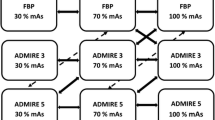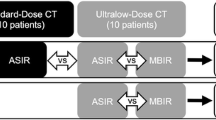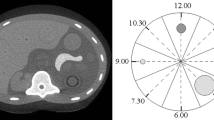Abstract
Objectives
To present the results of a systematic literature search aimed at determining to what extent the radiation dose can be reduced with iterative reconstruction (IR) for cardiopulmonary and body imaging with computed tomography (CT) in the clinical setting and what the effects on image quality are with IR versus filtered back-projection (FBP) and to provide recommendations for future research on IR.
Methods
We searched Medline and Embase from January 2006 to January 2012 and included original research papers concerning IR for CT.
Results
The systematic search yielded 380 articles. Forty-nine relevant studies were included. These studies concerned: the chest(n = 26), abdomen(n = 16), both chest and abdomen(n = 1), head(n = 4), spine(n = 1), and no specific area (n = 1). IR reduced noise and artefacts, and it improved subjective and objective image quality compared to FBP at the same dose. Conversely, low-dose IR and normal-dose FBP showed similar noise, artefacts, and subjective and objective image quality. Reported dose reductions ranged from 23 to 76 % compared to locally used default FBP settings. However, IR has not yet been investigated for ultra-low-dose acquisitions with clinical diagnosis and accuracy as endpoints.
Conclusion
Benefits of IR include improved subjective and objective image quality as well as radiation dose reduction while preserving image quality. Future studies need to address the value of IR in ultra-low-dose CT with clinically relevant endpoints.
Key Points
• Iterative reconstruction improves image quality of CT images at equal acquisition parameters.
• IR preserves image quality compared to normal-dose filtered back-projection.
• The reduced radiation dose made possible by IR is advantageous for patients.
• IR has not yet been investigated with clinical diagnosis and accuracy as endpoints.


Similar content being viewed by others
Abbreviations
- AIDR 3D:
-
Adaptive Iterative Dose Reduction 3D
- ASIR:
-
Adaptive Statistical Iterative Reconstruction
- CNR:
-
Contrast-to-noise ratio
- CT:
-
Computed tomography
- CTDIvol :
-
Volume Computed tomography dose index
- DLP:
-
Dose-length product
- FBP:
-
Filtered back-projection
- HU:
-
Hounsfield units
- IRIS:
-
Iterative Reconstruction in Image Space
- MBIR:
-
Model-Based Iterative Reconstruction
- SAFIRE:
-
Sinogram-Affirmed Iterative Reconstruction
- SNR:
-
Signal-to-noise ratio
References
Fleischmann D, Boas FE (2011) Computed tomography—old ideas and new technology. Eur Radiol 21:510–517
Pan X, Sidky EY, Vannier M (2009) Why do commercial CT scanners still employ traditional, filtered back-projection for image reconstruction? Inverse Probl 25:1230009
Nelson RC, Feuerlein S, Boll DT (2011) New iterative reconstruction techniques for cardiovascular computed tomography: how do they work, and what are the advantages and disadvantages? J Cardiovasc Comput Tomogr 5:286–292
Bittencourt MS, Schmidt B, Seltmann M et al (2011) Iterative reconstruction in image space (IRIS) in cardiac computed tomography: initial experience. Int J Cardiovasc Imaging 27:1081–1087
Leipsic J, Labounty TM, Heilbron B et al (2010) Adaptive statistical iterative reconstruction: assessment of image noise and image quality in coronary CT angiography. AJR Am J Roentgenol 195:649–654
Renker M, Nance JW Jr, Schoepf UJ et al (2011) Evaluation of heavily calcified vessels with coronary CT angiography: comparison of iterative and filtered back projection image reconstruction. Radiology 260:390–399
Utsunomiya D, Weigold WG, Weissman G, Taylor AJ (2011) Effect of hybrid iterative reconstruction technique on quantitative and qualitative image analysis at 256-slice prospective gating cardiac CT. Eur Radiol 22:1287–1294
Leipsic J, Heilbron BG, Hague C (2012) Iterative reconstruction for coronary CT angiography: finding its way. Int J Cardiovasc Imaging 28:613–620
Liberati A, Altman DG, Tetzlaff J et al (2009) The PRISMA statement for reporting systematic reviews and meta-analyses of studies that evaluate health care interventions: explanation and elaboration. Ann Intern Med 151:W65–W94
Månsson LG (2000) Methods for the evaluation of image quality: a review. Radiat Prot Dosim 90:89–99
Mieville FA, Gudinchet F, Rizzo E et al (2011) Paediatric cardiac CT examinations: impact of the iterative reconstruction method ASIR on image quality—preliminary findings. Pediatr Radiol 41:1154–1164
Sund P, Bath M, Kheddache S, Mansson LG (2004) Comparison of visual grading analysis and determination of detective quantum efficiency for evaluating system performance in digital chest radiography. Eur Radiol 14:48–58
Habets J, Symersky P, de Mol BA, Mali WP, Leiner T, Budde RP (2012) A novel iterative reconstruction algorithm allows reduced dose multidetector-row CT imaging of mechanical prosthetic heart valves. Int J Cardiovasc Imaging 28:1567–1575
Mueck FG, Korner M, Scherr MK et al (2011) Upgrade to Iterative Image Reconstruction (IR) in Abdominal MDCT Imaging: a clinical study for detailed parameter optimization beyond vendor recommendations using the Adaptive Statistical Iterative Reconstruction Environment (ASIR). Rofo 184:229–238
Funama Y, Taguchi K, Utsunomiya D et al (2011) Combination of a low-tube-voltage technique with hybrid iterative reconstruction (iDose) algorithm at coronary computed tomographic angiography. J Comput Assist Tomogr 35:480–485
Kambadakone AR, Chaudhary NA, Desai GS, Nguyen DD, Kulkarni NM, Sahani DV (2011) Low-dose MDCT and CT enterography of patients with Crohn disease: feasibility of adaptive statistical iterative reconstruction. AJR Am J Roentgenol 196:W743–W752
Hara AK, Paden RG, Silva AC, Kujak JL, Lawder HJ, Pavlicek W (2009) Iterative reconstruction technique for reducing body radiation dose at CT: feasibility study. AJR Am J Roentgenol 193:764–771
Schindera ST, Diedrichsen L, Muller HC et al (2011) Iterative reconstruction algorithm for abdominal multidetector CT at different tube voltages: assessment of diagnostic accuracy, image quality, and radiation dose in a phantom study. Radiology 260:454–462
Bulla S, Blanke P, Hassepass F et al (2012) Reducing the radiation dose for low-dose CT of the paranasal sinuses using iterative reconstruction: feasibility and image quality. Eur J Radiol 81:2246–2250
Leipsic J, Labounty TM, Heilbron B et al (2010) Estimated radiation dose reduction using adaptive statistical iterative reconstruction in coronary CT angiography: the ERASIR study. AJR Am J Roentgenol 195:655–660
Prakash P, Kalra MK, Digumarthy SR et al (2010) Radiation dose reduction with chest computed tomography using adaptive statistical iterative reconstruction technique: initial experience. J Comput Assist Tomogr 34:40–45
Renker M, Ramachandra A, Schoepf UJ et al (2011) Iterative image reconstruction techniques: applications for cardiac CT. J Cardiovasc Comput Tomogr 5:225–230
Marin D, Nelson RC, Schindera ST et al (2010) Low-tube-voltage, high-tube-current multidetector abdominal CT: improved image quality and decreased radiation dose with adaptive statistical iterative reconstruction algorithm—initial clinical experience. Radiology 254:145–153
Kilic K, Erbas G, Guryildirim M, Arac M, Ilgit E, Coskun B (2011) Lowering the dose in head CT using adaptive statistical iterative reconstruction. AJNR Am J Neuroradiol 32:1578–1582
Mitsumori LM, Shuman WP, Busey JM, Kolokythas O, Koprowicz KM (2012) Adaptive statistical iterative reconstruction versus filtered back projection in the same patient: 64 channel liver CT image quality and patient radiation dose. Eur Radiol 22:138–143
Park EA, Lee W, Kim KW et al (2012) Iterative reconstruction of dual-source coronary CT angiography: assessment of image quality and radiation dose. Int J Cardiovasc Imaging 28:1775–1786
Sagara Y, Hara AK, Pavlicek W, Silva AC, Paden RG, Wu Q (2010) Abdominal CT: comparison of low-dose CT with adaptive statistical iterative reconstruction and routine-dose CT with filtered back projection in 53 patients. AJR Am J Roentgenol 195:713–719
Lee SJ, Park SH, Kim AY et al (2011) A prospective comparison of standard-dose CT enterography and 50 % reduced-dose CT enterography with and without noise reduction for evaluating Crohn disease. AJR Am J Roentgenol 197:50–57
Cornfeld D, Israel G, Detroy E, Bokhari J, Mojibian H (2011) Impact of Adaptive Statistical Iterative Reconstruction (ASIR) on radiation dose and image quality in aortic dissection studies: a qualitative and quantitative analysis. AJR Am J Roentgenol 196:W336–W340
Vorona GA, Ceschin RC, Clayton BL, Sutcavage T, Tadros SS, Panigrahy A (2011) Reducing abdominal CT radiation dose with the adaptive statistical iterative reconstruction technique in children: a feasibility study. Pediatr Radiol 41:1174–1182
Prakash P, Kalra MK, Kambadakone AK et al (2010) Reducing abdominal CT radiation dose with adaptive statistical iterative reconstruction technique. Investig Radiol 45:202–210
Flicek KT, Hara AK, Silva AC, Wu Q, Peter MB, Johnson CD (2010) Reducing the radiation dose for CT colonography using adaptive statistical iterative reconstruction: a pilot study. AJR Am J Roentgenol 195:126–131
Pontana F, Duhamel A, Pagniez J et al (2011) Chest computed tomography using iterative reconstruction vs filtered back projection (Part 2): image quality of low-dose CT examinations in 80 patients. Eur Radiol 21:636–643
Korn A, Fenchel M, Bender B et al (2011) Iterative reconstruction in head CT: image quality of routine and Low-dose protocols in comparison with standard filtered back-projection. AJNR Am J Neuroradiol 33:218–224
Sato J, Akahane M, Inano S et al (2011) Effect of radiation dose and adaptive statistical iterative reconstruction on image quality of pulmonary computed tomography. Jpn J Radiol 30:146–153
May MS, Wust W, Brand M et al (2011) Dose reduction in abdominal computed tomography: intraindividual comparison of image quality of full-dose standard and half-dose iterative reconstructions with dual-source computed tomography. Investig Radiol 46:465–470
Winklehner A, Karlo C, Puippe G et al (2011) Raw data-based iterative reconstruction in body CTA: evaluation of radiation dose saving potential. Eur Radiol 21:2521–2526
Moscariello A, Takx RA, Schoepf UJ et al (2011) Coronary CT angiography: image quality, diagnostic accuracy, and potential for radiation dose reduction using a novel iterative image reconstruction technique-comparison with traditional filtered back projection. Eur Radiol 21:2130–2138
Gervaise A, Osemont B, Lecocq S et al (2012) CT image quality improvement using adaptive iterative dose reduction with wide-volume acquisition on 320-detector CT. Eur Radiol 22:295–301
Irwan B, Nakanishi S, Blum A (2012) AIDR 3D—Reduces Dose and Simultaneously Improves Image Quality. Toshiba Medical Systems Whitepaper. Available via http://www.toshiba-medical.eu/upload/TMSE_CT/White%20Papers/White%20Papers/Toshiba_White%20paper%20CT_nov11.pdf?epslanguage=en. Accessed Nov 2012
Philips Healthcare (2011) iDose4 iterative reconstruction technique. Philips Healthcare Whitepaper. Available via https://www.healthcare.philips.com/pwc_hc/main/shared/Assets/Documents/ct/idose_white_paper_452296267841.pdf. Accessed Nov 2012
Christner JA, Kofler JM, McCollough CH (2010) Estimating effective dose for CT using dose-length product compared with using organ doses: consequences of adopting International Commission on Radiological Protection publication 103 or dual-energy scanning. AJR Am J Roentgenol 194:881–889
Prakash P, Kalra MK, Ackman JB et al (2010) Diffuse lung disease: CT of the chest with adaptive statistical iterative reconstruction technique. Radiology 256:261–269
Hu XH, Ding XF, Wu RZ, Zhang MM (2011) Radiation dose of non-enhanced chest CT can be reduced 40 % by using iterative reconstruction in image space. Clin Radiol 66:1023–1029
Leipsic J, Nguyen G, Brown J, Sin D, Mayo JR (2010) A prospective evaluation of dose reduction and image quality in chest CT using adaptive statistical iterative reconstruction. AJR Am J Roentgenol 195:1095–1099
Pontana F, Pagniez J, Flohr T et al (2011) Chest computed tomography using iterative reconstruction vs filtered back projection (Part 1): Evaluation of image noise reduction in 32 patients. Eur Radiol 21:627–635
Yanagawa M, Honda O, Kikuyama A et al (2012) Pulmonary nodules: Effect of adaptive statistical iterative reconstruction (ASIR) technique on performance of a computer-aided detection (CAD) system-Comparison of performance between different-dose CT scans. Eur J Radiol 81:2877–2886
Min JK, Swaminathan RV, Vass M, Gallagher S, Weinsaft JW (2009) High-definition multidetector computed tomography for evaluation of coronary artery stents: comparison to standard-definition 64-detector row computed tomography. J Cardiovasc Comput Tomogr 3:246–251
European Study Group (1999) European Guidelines on Quality Criteria for Computed Tomography: Report EUR 16262. Danish Society of Radiology Website. Available via http://www.drs.dk/guidelines/ct/quality/index.htm. Accessed Nov 2012
Mayo JR, Aldrich J, Muller NL (2003) Radiation exposure at chest CT: a statement of the Fleischner Society. Radiology 228:15–21
Yanagawa M, Honda O, Yoshida S et al (2010) Adaptive statistical iterative reconstruction technique for pulmonary CT: image quality of the cadaveric lung on standard- and reduced-dose CT. Acad Radiol 17:1259–1266
Singh S, Kalra MK, Hsieh J et al (2010) Abdominal CT: comparison of adaptive statistical iterative and filtered back projection reconstruction techniques. Radiology 257:373–383
Martinsen AC, Saether HK, Hol PK, Olsen DR, Skaane P (2012) Iterative reconstruction reduces abdominal CT dose. Eur J Radiol 81:1483–1487
Matsuda I, Hanaoka S, Akahane M et al (2010) Adaptive statistical iterative reconstruction for volume-rendered computed tomography portovenography: improvement of image quality. Jpn J Radiol 28:700–706
Gosling O, Loader R, Venables P et al (2010) A comparison of radiation doses between state-of-the-art multislice CT coronary angiography with iterative reconstruction, multislice CT coronary angiography with standard filtered back-projection and invasive diagnostic coronary angiography. Heart 96:922–926
Scheffel H, Stolzmann P, Schlett CL et al (2011) Coronary artery plaques: Cardiac CT with model-based and adaptive-statistical iterative reconstruction technique. Eur J Radiol 81:e363–e369
Honda O, Yanagawa M, Inoue A et al (2011) Image quality of multiplanar reconstruction of pulmonary CT scans using adaptive statistical iterative reconstruction. Br J Radiol 84:335–341
Singh S, Kalra MK, Gilman MD et al (2011) Adaptive statistical iterative reconstruction technique for radiation dose reduction in chest CT: a pilot study. Radiology 259:565–573
Noel PB, Fingerle AA, Renger B, Munzel D, Rummeny EJ, Dobritz M (2011) Initial performance characterization of a clinical noise-suppressing reconstruction algorithm for MDCT. AJR Am J Roentgenol 197:1404–1409
Author information
Authors and Affiliations
Corresponding author
Appendices
Appendices
Search terms for PubMed
(“iterative reconstruction” [Title/Abstract] OR ASIR [Title/Abstract] OR (adaptive [Title/Abstract] AND statistical [Title/Abstract] AND iterative [Title/Abstract] AND reconstruction [Title/Abstract]) OR idose [Title/Abstract] OR iris [Title/Abstract] OR (iterative [Title/Abstract] AND reconstruction [Title/Abstract] AND image [Title/Abstract] AND space [Title/Abstract]) OR AIDR [Title/Abstract] OR (adaptive [Title/Abstract] AND iterative [Title/Abstract] AND dose [Title/Abstract] AND reduction [Title/Abstract])) AND (CT [Title/Abstract] OR “Tomography, X-Ray Computed” [Mesh] OR “Cone-Beam Computed Tomography” [Mesh] OR “Four-Dimensional Computed Tomography” [Mesh] OR “Spiral Cone-Beam Computed Tomography” [Mesh] OR “Tomography Scanners, X-Ray Computed” [Mesh] OR “Tomography, Spiral Computed” [Mesh]) AND English [lang] AND “last 5 years” [PDat]
Search terms for EMBASE
‘iterative reconstruction’:ab,ti OR asir:ab,ti OR (adaptive:ab,ti AND statistical:ab,ti AND iterative:ab,ti AND reconstruction:ab,ti) OR idose:ab,ti OR iris:ab,ti OR (iterative:ab,ti AND reconstruction:ab,ti AND image:ab,ti AND space:ab,ti) OR aidr:ab,ti OR (adaptive:ab,ti AND iterative:ab,ti AND dose:ab,ti AND reduction:ab,ti) AND (ct:ab,ti OR ‘tomography, x-ray computed’:ab,ti OR ‘cone-beam computed tomography’:ab,ti OR ‘four-dimensional computed tomography’:ab,ti OR ‘spiral cone-beam computed tomography’:ab,ti OR ‘tomography scanners, x-ray computed’:ab,ti OR ‘tomography, spiral computed’:ab,ti) AND [english]/lim AND [embase]/lim AND [2006–2012]/py
Rights and permissions
About this article
Cite this article
Willemink, M.J., Leiner, T., de Jong, P.A. et al. Iterative reconstruction techniques for computed tomography part 2: initial results in dose reduction and image quality. Eur Radiol 23, 1632–1642 (2013). https://doi.org/10.1007/s00330-012-2764-z
Received:
Revised:
Accepted:
Published:
Issue Date:
DOI: https://doi.org/10.1007/s00330-012-2764-z




